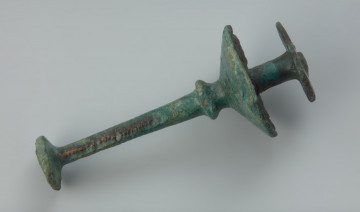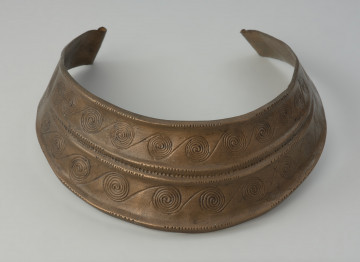
Chest
1796
National Museum in Szczecin
Part of the collection: Bronze Age
The decorative, bronze tutulus (a small, conical object) was found in an urn placed in a cist grave, located in a cemetery in Unieradz, and dated to the Late Bronze Age (ca. 1100-900 BC). It consists of two plates and a spike. The upper plate is richly ornamented with grooves, azure, carved lines, notches, and a solar motif, while the bottom plate is in the form of a wheel with four spokes. It was imported from regions inhabited by the population of the culture of the Nordic Bronze Age. The tutulus originated in the period of shifts in belief systems that occurred throughout Europe. The shift included the popularization of the Sun worship. Burial methods also changed – cremation graves were replaced by inhumation graves. The fascination with celestial bodies was also manifested in additional dress accessories, namely in lunulae and discs – symbols of the Moon and the Sun. The population of the Late Bronze Age was familiar with astronomy and a calendar system. Stone engravings found in Scandinavia depict the motif of the Sun travel on a boat or a horse carriage. The population of the Bronze Age is distinguished by a strong affinity to symbols, various kinds of rituals and cycles, like life and death or day and night.
Monika Witek
Author / creator
Dimensions
the entire object: height: 4 cm
Object type
costium adorment
Material
bronze
Origin / acquisition method
legal transfer
Creation time / dating
Creation / finding place
Owner
National Museum in Szczecin
Identification number
Location / status

1796
National Museum in Szczecin

around 1100 p.n.e. — 900 p.n.e.
National Museum in Szczecin

around 1300 p.n.e. — 1200 p.n.e.
National Museum in Szczecin
DISCOVER this TOPIC
Castle Museum in Łańcut
DISCOVER this PATH
Educational path